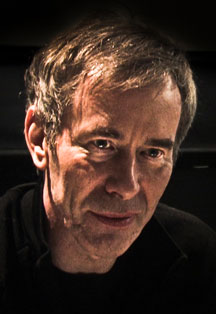Science on Tap to feature Purdue physicist on what's next in the pursuit of 'God particle'
October 5, 2012
WEST LAFAYETTE, Ind. – An award-winning Purdue University physicist who was part of the international research team that may have discovered what's known as the "God particle," or the Higgs boson, is the next Science on Tap speaker on Monday (Oct. 8).
 |
|
Ian Shipsey |
Ian Shipsey, the Julian Schwinger Distinguished Professor of Physics at Purdue, will give the talk, titled "In the Shadow of the Higgs: The Greatest Discovery in Particle Physics in 30 years," at 6 p.m. in the upstairs of the Lafayette Brewing Company, 622 Main St., Lafayette.
During his Science on Tap talk, Shipsey will discuss what the Higgs boson is, the methods used to observe it, what signals were seen and what additional research is needed to confirm whether scientists this summer actually discovered the Higgs boson.
"Predicted in the 1960s, the Higgs is the only missing piece of the Standard Model, which is the prevailing theory of particle physics," Shipsey said. "If the Higgs did not exist, atoms would not exist and neither would we."
The event, which is free and open to those 21 and older, is sponsored by the Purdue College of Science, the Department of Physics and Discovery Park.
On July 4 Shipsey joined scientists at Purdue and throughout the world in celebrating the discovery of a new subatomic particle that may be the long-sought Higgs boson, which shapes understanding about the composition and interaction of all matter in the universe.
The scientists conducted experiments using the 27 kilometer-long Large Hadron Collider (LHC), the largest machine ever built by mankind. The giant atom smasher is located at the Conseil Européen pour la Recherche Nucléaire, or CERN, in Geneva, Switzerland.
Superconducting magnets that drive the collider are kept at 1.9 Kelvins, colder than outer space, and billions of protons traveling near the speed of light collide at the world record energy of 8 trillion electron volts. Energy from the collisions transform into subatomic particles, which may never have been seen before and some of which live for one-trillionth-of-one-trillionth of a second.
In the field of particle physics, the Standard Model describes the basic building blocks of matter and their interactions, and its explanations of elementary particles and forces have held true through more than four decades of experimental testing.
Higgs bosons, if they exist, are short-lived and quickly decay into other particles. Because scientists cannot look directly for the particle, its discovery relies on observations of excess amounts of the particles into which it can decay. The Higgs boson remains the only missing piece of the model and, without it the critical component of how these particles obtain mass cannot be explained.
"Has the Higgs particle finally been found? Or perhaps this is another particle not yet anticipated - a messenger from the dark side of the universe," Shipsey said. "Either way, this is the biggest discovery in particle physics in the last 30 years."
The Higgs boson is named after Peter Higgs, a professor of physics at the University of Edinburgh who first suggested the particle as the mechanism that gives mass to matter.
Shipsey was a graduate student at the University of Edinburgh and attended classes taught by Higgs. During this summer's announcement in Switzerland, Shipsey reconnected with Higgs for the first time in 20 years.
As part of the project, Shipsey and Daniela Bortoletto, the Edward Purcell Distinguished Professor of Physics at Purdue, led the camera design and assembly teams. Shipsey also participated in the internal reviewing process.
Shipsey was recently elected chair of the Compact Muon Solenoid (CMS) Collaboration Board at CERN. Bortoletto is upgrade coordinator of the U.S. CMS, responsible for coordinating the 47 U.S. universities working to upgrade the CMS camera.
Shipsey, who has been deaf since the age of 30, also is co-coordinator of the Large Hadron Collider Physics Center at Fermilab near Chicago.
He received an NSF National Young Investigator Award in 1992 and an SSC National Fellowship in 1993. Shipsey has received teaching prizes at the departmental, college and university levels and was inducted into Purdue's Book of Great Teachers in 2003.
The Science on Tap lecture series, led by Purdue graduate students Patrick Dolan, Shaili Sharma and Becca Scott, provides Purdue faculty and collaborating researchers the opportunity to share research activities in an informal setting, with presentations that are designed to appeal to a more general audience.
Attendance at the monthly event has averaged 80 during the program's first two years.
Writer: Phillip Fiorini, 765-496-3133, pfiorini@purdue.edu
Sources: Ian Shipsey, (765) 494-5391, shipsey@physics.purdue.edu
Patrick Dolan, 765-496-9336, pdolan@purdue.edu

